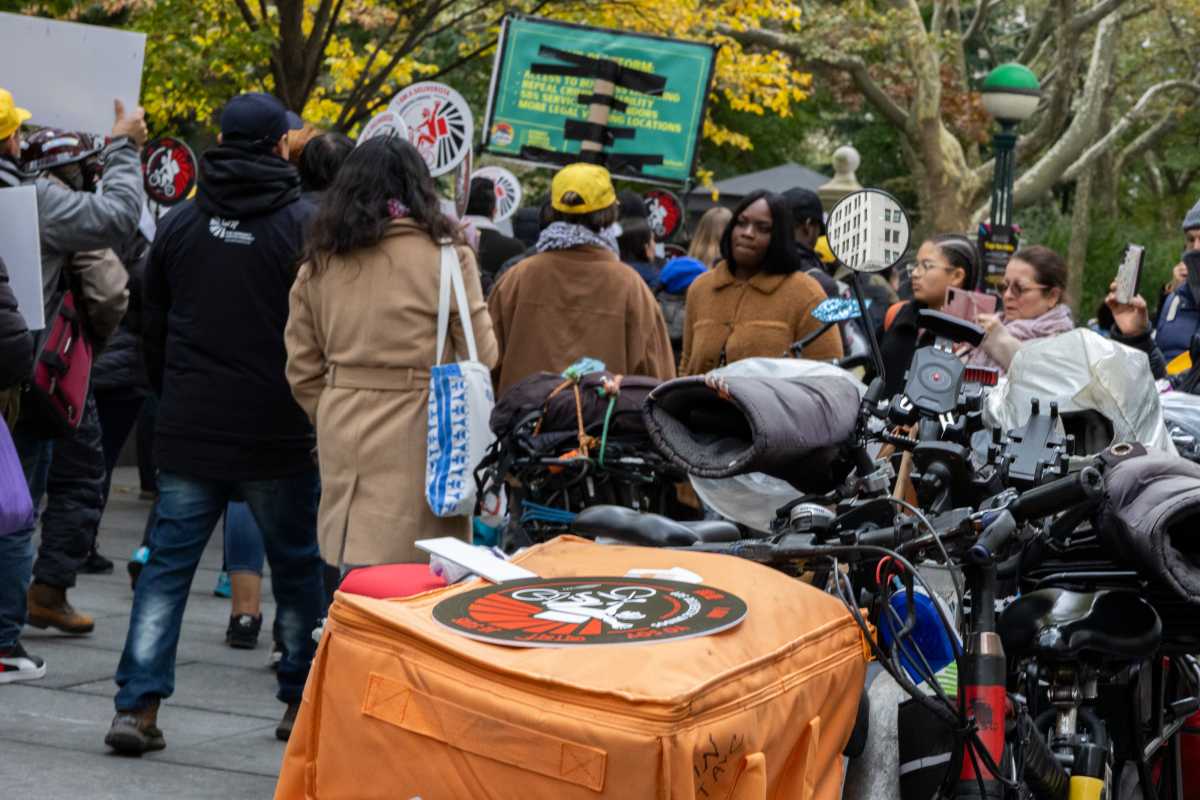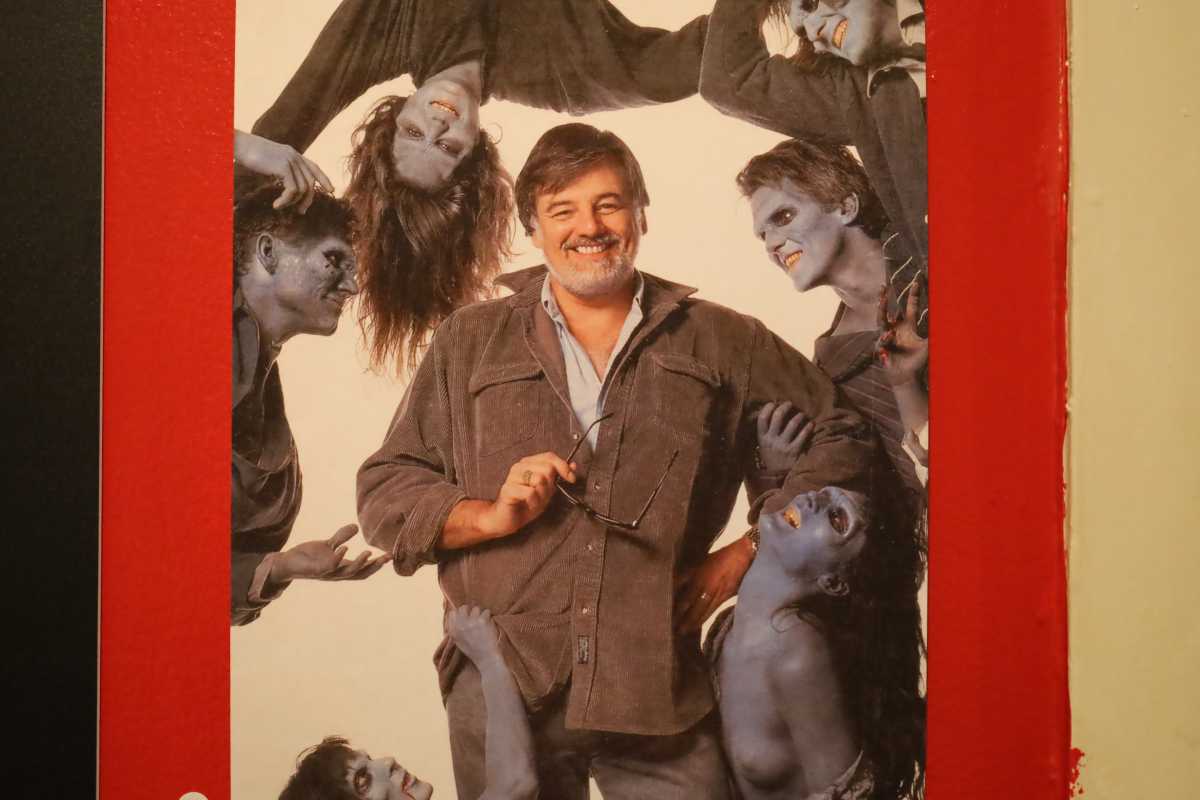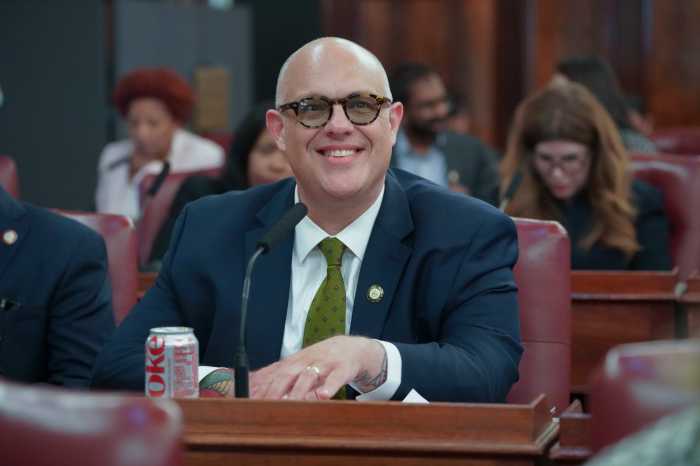By Lincoln Anderson
The last few years in the Meat Market have seen battles waged successfully to preserve its manufacturing zoning and to landmark the district.
A plan for a 32-story tower on Washington St. was defeated twice by a coalition of Villagers, preservationists, meat-packers and bar and nightclub owners — first when it was proposed as fully residential, the second time as 50 percent residential. Last year, the new Gansevoort Historic District was designated.
The idea was that the Meat Market was a perfect 24-hour ecosystem of galleries and boutiques, nightlife and meat businesses. But nightlife is taking over.
To the dismay of residents living on the edges of the Meat Market as well as those few residing legally in the Market itself, the area has now blown up into a virtual bar and nightclub theme park with only more bars, nightclubs and another hotel on the way.
The opening this year of the Hotel Gansevoort along with One, PM, Vento and Spice Market — the latter four all with large nightclub or lounge spaces — has morphed Gansevoort Sq., the five-way intersection at the end of Ninth Ave., into a virtual Times Sq. South.
Residents are saying the line must now be drawn against granting new liquor licenses in order to keep the area from being completely overrun by bars and clubs. Community Board 2 must somehow persuade the State Liquor Authority to stop issuing new liquor licenses, they say, and the S.L.A. must enforce the 500-ft. rule, which in theory is supposed to be a check against bar oversaturation.
There is a competing idea, however, being offered to keep nightclub proliferation in check: Some think allowing new residential use in the manufacturing-zoned district would help, even though this idea has been taboo so far among most but the property owners.
Meanwhile, nightlife advocates dismiss the idea that the Meat Market’s bar scene has grown out of control. They call residential an “insane” idea that would create an all-out war between residents and nightlife.
Starting in November, people living within a radius a few blocks around the Meat Market, particularly those to the south, have noticed a spillover effect and an increase of car traffic from the new club scene.
“We protected the M1-5 zoning,” said Elaine Young, former head of M1-5, the group that fought the 32-story tower, who lives on Jane St. “But what’s happening is there are so many liquor licenses coming in. In 2001, there were 23 liquor licenses. By this time in 2004, if two more are approved, there’ll be 36. People are nervous about the explosion of liquor licenses.
“We know that M1-5 allows others things,” Young continued. “But it seems like it’s all clubs. It’s like a club monster. We have a right to demand more kinds of businesses.”
New uses residents would prefer to see in the Meat Market, according to Young are “movie theaters, cultural and art stuff — or an amazing food store, like Fairway.”
Young said they want the State Liquor Authority to seriously apply the 500-ft. rule, which requires a review when a new liquor license application is within 500 ft. of three existing licenses to determine if the license would be in the public’s benefit.
“We feel that this rule is not being applied at all,” she said.
In addition, she accused Community Board 2, which reviews the applications and gives its recommendations to the S.L.A., of being “just kind of a rubber stamp.”
“Community Board 2 is not helping us, the residents,” she said.
Nancy Blanford lives on Greenwich St., between Gansevoort and Horatio Sts., a main feeder for the traffic into the clubs in Gansevoort Sq. She said she knows the traffic is from the clubs, because when PM was closed for three days a few months ago for allowing dancing without a cabaret license there was a noticeable difference.
“We look right out over Gansevoort Plaza, which was a nightmare intersection even before this,” she said. “There’s been a heavy, huge influx of limos and taxis. That weekend when PM was closed it was just totally quiet.”
The volume of cars coming into the intersection as well as cars standing there is also dangerous, in her view.
“There’s going to be a major accident there one day,” she said.
But residents’ complaints aren’t only coming from the Market’s edges, but also from within the district. There are up to two dozen legal residents in the Meat Market. The apartments were grandfathered for residential use after continuous occupancy from 1977 could be shown.
Ivy Jeanne Brown lives in one of the five residential apartments in the Triangle Building, on Ninth Ave. between 14th and 13th Sts.
“I’ve been here 19 years,” she said. “I’ve seen four children in this building grow up and go to college.”
Brown runs a photo gallery in her joint live-work space. Other residential tenants include a performance artist and cook. A former tenant was a guy named the Pope of Pot; he ran a delivery service.
Another building in which residential use is grandfathered is the Kelly Building across the street, with Gaslight Bar on the ground floor.
The Triangle Building residents have found themselves living literally at the epicenter of the nightlife explosion, as Vento, Stephen Hanson’s new Italian restaurant, opened downstairs, and Level V, a nightclub, opened in the basement.
“I get the noise of Vento,” Brown said. “My neighbors get more the noise of Hotel Gansevoort.”
Hanson originally promised the basement would only be a holding area for customers for the restaurant. How Hanson was able to get the nightclub in the basement isn’t clear, but those in the know say he is well connected in the Bloomberg administration; they note, for example, that the bus stop previously on Ninth Ave. by Vento somehow suddenly got moved. The flower boxes and tables of the sidewalk café frequently spread out too far, eating up the sidewalk, the residents say.
Brown said she preferred it before with the transgender prostitutes and the sex clubs.
“With all the sex clubs, the people just went downstairs. Yeah, every now and then the transvestites would have a full-on catfight — and the meat trucks used to come at 3 a.m. or 4 a.m. Now, everyone stands there on the corner with their cellphone and their cigarette. It’s the noise and the attitude. You get a lot of drunk people now. I feel more vulnerable.
“What we want is the Flower Market down here,” she said. “We’d love a museum and a movie theater.”
To fight back against the nightlife invasion, residents living in the Market, along with some living on the periphery, are forming the Gansevoort Market Alliance. Brown is the president.
The group planned to make its debut on Tuesday at C.B. 2’s Business Committee to object to a liquor license application for Buddha Bar, a new mega-club looking to open in the Collier’s Building on 13th Sts.
The situation is such that some residents are mentioning the “R” word. Marjorie Colt, a member of the Horatio St. Association, said opposing all residential use may have been a mistake.
“Now it seems that had residential been allowed, we would not have this horrendous condition that exists,” Colt said in an e-mail. “The tower, however, was completely unacceptable and I opposed it completely. As to reopening the idea of residential now, I said this — not as someone convinced of the fact — but just as someone who sees that the process seems to have gone wrong.”
Bob Rinaolo, chairperson of Community Board 2’s Business Committee, said he and Carol Yankay, head of Board 2’s 14th Street/Gansevoort Area Committee’s, had warned that without a residential presence, the Meat Market would become a bar zone.
“I’ve been saying this for the last three years,” he said. “I said eliminating residential from the mix there would create this problem — that without residents to object to things there, you were going to get one big bar. They got it landmarked and fought residential. Now, all of a sudden that what we predicted happened, it became the board’s fault.
“I know people don’t want big towers in their backyard,” Rinaolo added, “but limited residential development could help.”
Rinaolo said the first time the community protested over the nightlife explosion was three months ago, against a cabaret license application by PM. However, the Department of Consumer Affairs automatically issues cabaret licenses — which allow dancing — if the zoning and other conditions are correct. In what was seen as a first shot against the nightclub proliferation, the Business Committee and Board 2’s full board voted to deny the cabaret license. But a few weeks later, PM was issued the cabaret license.
Although Village residents initially opposed a liquor license for Narcisse, another big club trying to open on 13th St., the opposition faded and Board 2 approved the license.
“Now all of a sudden, they’re asking for a moratorium” on new liquor licenses, Rinaolo said. “Before, anyone that came for a license, there was very little opposition from the public.”
Rinaolo said that while most of the new liquor licenses have been around Gansevoort Sq., the new applications — like Buddha Bar and Narcisse — are moving into “the depths” of the Meat Market. The space Buddha Bar is looking at on the first floor of the Collier’s Building is huge, 14,000 sq. ft. Although the applicant says they only want to use half of the space, for a 280-seat restaurant, Rinaolo is skeptical.
“Originally, I heard it was going to be a 2,000-person capacity club,” he said. “The operator is now saying it will be a large, French restaurant designed by I.M. Pei.” Rinaolo said with that amount of space, the restaurant pitch sounds like a “stalking horse” for a disco.
Jim Smith, C.B. 2 chairperson, said the board’s invoking a moratorium on new liquor licenses in the Market would be counterproductive.
“Just saying that there are too many bars won’t cut it with the S.L.A.,” Smith said. “To have any chance of winning a denial where it counts — at the S.L.A. — we must appraise each application and justify our recommendation based on the facts of the specific case. Kneejerk naysaying gets discounted at the S.L.A. and elsewhere.”
As for accusations that the board is the S.L.A.’s “rubber stamp,” Smith said, “Anyone who says that is putting the cart before the horse. The board recommends, the S.L.A. decides. The S.L.A. needs to take the 500-ft. rule more seriously and more faithfully respect the board’s recommendations of denial.”
Jo Hamiliton, a member of Board 2 who lives on Jane St., said allowing residential use in the Meat Market could perhaps be a long-term plan, but that in the immediate short term, Board 2 must become more proactive.
“That’s not going to happen overnight,” Hamilton said, regarding new residential use. “That’s going to take some time. And City Planning has no interest in doing that at this time.”
She said a wider discussion with all stakeholders is also needed before any decision is made to support new residential use.
Hamilton was co-chairperson of Save the Gansevoort Market, the group that got the Meat Market landmarked. But she said that organization is basically ending and that now she is just trying to represent the views of local residents as a member of Board 2.
“Right now, we have to enforce the 500-ft. rule,” Hamilton said. “The S.L.A. has to say, ‘Is this [license] going to change the neighborhood?’ And clearly, now that we’re up to 40 licenses — if you count the places extending up into Chelsea, I mean these are really big places — the answer is yes.
“We’re not asking for a moratorium,” she added. “We just want the board to make a good argument against each license. In the short term, we need the community board behind the community and advocating for us to the S.L.A. that there are too many liquor licenses in the Gansevoort Market Neighborhood.”
Florent Morellet, co-chairperson of Save Gansevoort Market, opposes increasing residential use.
“I think it’s important to keep it a mix,” he said. “But if you were to put in residential now, it would be a nightmare. You would have a civil war on your hands. The alternative is to use the 500-ft. rule and say, ‘That’s enough.’ ”
Morellet said he feels it’s important to keep the meat-packers in the neighborhood, that that’s why they fought to keep the M1-5 zoning and are now working to bring in the Flower Market.
“You still have a whole block owned by the city. They are getting new leases,” he noted of the meat co-op on Gansevoort St., in which 10 meatpacking companies are tenants. “Residents in the neighborhood are not the solution, and they will really knock out the meatpackers, who have been there 50 years. It’s not fair.”
Yet, Morellet, who owns a restaurant on Gansevoort St., said the area is indeed becoming a circus.
“It’s starting to look on weekend nights like Bourbon St.,” he said. “The neighborhood hasn’t had time to adjust. We need to pause and strategize and look at it before it’s too late.”
Morellet said some of the more high-class places are even complaining about losing customers because of the hyper scene.
“Jean-Georges said to me he was surprised at the crowds on the weekend, and he has to have someone at the door. That wasn’t what he expected,” Morellet said, referring to famous chef Jean-Georges Vongerichten, of Spice Market on 13th St.
“All these places have a huge bar component,” Morellet continued. “Vento has a huge basement, it’s a nightclub. Spice Bar, the same.”
Andrew Berman, director of Greenwich Village Society for Historic Preservation, said G.V.S.H.P. also opposes allowing new residential use because it could drive out the meat packers.
“The meatpackers could get pushed out very quickly by people complaining about them doing nothing other than operating their businesses — from the smell, the traffic, the noise,” Berman said. “And we’re not just concerned with allowing the meatpackers to stay there, but what we would get in their stead if they were forced out.”
David Rabin, president of the New York Nightlife Association and a partner in Lotus restaurant and nightclub on W. 14th St., called allowing residential use in the Meat Market “insane,” noting that manufacturing districts were designated for large nightclubs to keep nightlife and residents separated. Where residents have moved into M zones, like in the Flatiron, it’s caused conflict, he said.
“The Meat Market’s saving grace is that no one lives there,” Rabin said. “To add residential would create the problem we have in the Flatiron. That’s all we talk about on Board 5, of which I’m a member. This area was zoned for this use and it’s being used for this use. There’s nowhere else for this use to go — except for Hoboken.”
Rabin said the new smoking law and the warm weather are inflaming the problem. He also blasted Community Board 2 for not voting to support Paid Detail for bars, clubs and restaurants, under which these businesses could hire off-duty police officers to stand outside and control crowd noise. Boards 3, 4 and 5 support Paid Detail.
But Rabin did acknowledge that the effects of the new nightlife district are being felt on neighboring streets.
“What we have to do is come up for a solution for the perimeter of the Meatpacking District,” he said, though not offering specifics.
An advocate of allowing some residential development and conversions of existing buildings in the Meat Market is James Ortenzio, president of Long Island Beef, who is known as the “Mayor of the Meat Market.”
The way Ortenzio sees it, there are a lot of “B.T.U.’s” in the Meat Market now with all the heat being produced from the new nightlife. A “firewall” is needed to stop the spread. That firewall, in his opinion, is residential.
“Now they feel this is a form of spontaneous combustion and they can’t control it, and they’re right,” he said of the burgeoning nightlife scene.
“They were always against residential and I didn’t particularly care. But when you have residential, you have a form of community and you have rules,” Ortenzio said. “That’s what doesn’t exist here. Residential is what keeps things under control.”
A year or two ago, many landlords in the Meat Market supported the idea of going residential, because the property value would be higher; but now they want commercial use, because the value has risen just as high, Ortenzio said. He said he knows of landlords in the Market getting $40-$50 per sq. ft. for commercial space on second floors.
Ortenzio said he thinks Washington St. across from the city-owned co-op building would be a good “firewall” spot for residential. He could also see the Atlas meat building, owned by Michael Romanoff, at Washington and 13th Sts., as a “firewall” against a hotel across the street.
Residents would bring in stores for shopping and household items.
“There’s no place you can go for coffee,” he noted.
Ortenzio, who owns a building diagonally across the intersection from the Atlas building, said he’s received offers to buy it and an offer from a large clothing retailer to pay him four times the rent he’s currently getting from meat businesses there. He’s got other ideas, though. He might like to put four stories above for 20 apartments or offices, or maybe even a movie theater.
A man who speaks to all sides in the Meat Market, from residents to developers, Ortenzio is trying to push things in the right direction. He said he’s hoping to convince a developer to bring an arts publishing house into a building on 14th St. the developer recently leased from Eastern Meats.
Ortenzio said although they’re reluctant to admit it publicly, “several community activists” he talks to are now saying new residential use should be allowed in the Meat Market.
“A lot of people say, ‘We were against it, how could we change?’ ” he noted. “Well, don’t change, and see what you get.”
For More: https://www.amny.com/news/movies-with-air-conditioning-on-pier/








































